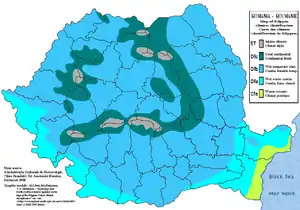Climate of Romania
The climate of Romania is temperate continental transitioning into an oceanic climate on the eastern coast, influenced by Scandinavian-Baltic weather, the Mediterranean and the Black Sea. Thus, in the south, there are some influences of a mediterranean climate, characterized by mild winters and stronger rainfalls in the cooler months (especially in autumn). In the south-east, the Black Sea induces rare heavy strong rains. In eastern regions the continental character is less pronounced. In the north of the country (Maramureș and Bukovina), the effect of the Scandinavian-Baltic climate is felt, effecting a wetter and colder climate with cold winters. The west of the country has a more pronounced influence of low pressure systems generated over the Atlantic, causing moderate temperatures and stronger precipitation. Climate nuances are demonstrated on the steps of the altitude, the mountain ranges of the Carpathian arc have a cool mountain climate with high humidity throughout the year.[1]
| Geography of Romania |
| Topography |
| Hydrography |
| Climate |
The average annual temperature is 11 °C (51.8 °F) in the south and middle-south and 8 °C (46.4 °F) in northeast. In Bucharest, the temperature ranges from an average low of −5 °C (23 °F) in January to an average high of 29 °C (84.2 °F) in July and August, with average temperatures of −3 °C (26.6 °F) in January and 23 °C (73.4 °F) in July and August. Rainfall, although adequate throughout the country, decreases from west to east and from mountains to plains. Some mountainous areas receive more than 1,010 mm (39.8 in) of precipitation each year. Annual precipitation averages about 635 mm (25 in) in central Transylvania, 521 mm (20.5 in) at Iaşi in Moldavia, and only 381 mm (15 in) at Constanţa on the Black Sea.

-Rum%C3%A4nien.png.webp)
Owing to its distance from the open ocean, Romania has a continental climate. Summers are generally very warm to hot, with average highs in Bucharest being around 29 °C (84.2 °F), with temperatures over 35 °C (95 °F) not unknown in the lower-lying areas of the country. Night time lows in Bucharest and other lower-lying areas are around 18 °C (64.4 °F), but at higher altitudes both maxima and minima decline considerably.

In the coldest months of winter (December and January) temperatures average between 3˚C and -15˚C. During winter, the skies are often cloudy and snowfall is quite common. In the plains of Romania there are about thirty days with snowfall per year.Winters are quite cold, with average highs even in lower-lying areas being no more than 3 °C (37.4 °F) and below −15 °C (5 °F) in the highest mountains.
Precipitation is generally modest, averaging over 750 mm (29.5 in) only on the highest west-facing mountain slopes – much of it falling as snow which allows for an extensive skiing industry. In the Danube delta, rainfall is very low, averaging only around 370 mm (14.6 in) per year, whilst further west along the southern plains around Bucharest it amounts to around 530 mm (20.9 in).
Records
The absolute minimum temperature was −38.5 °C (−37.3 °F), registered near Brașov in 1942. The absolute maximum temperature was 44.5 °C (112.1 °F), recorded at Ion Sion, Brăila County in 1951.[2]
| Climate data for Romania | |||||||||||||
|---|---|---|---|---|---|---|---|---|---|---|---|---|---|
| Month | Jan | Feb | Mar | Apr | May | Jun | Jul | Aug | Sep | Oct | Nov | Dec | Year |
| Record high °C (°F) | 22.2 (72.0) |
26.0 (78.8) |
32.8 (91.0) |
35.5 (95.9) |
40.8 (105.4) |
42.0 (107.6) |
44.3 (111.7) |
44.5 (112.1) |
43.5 (110.3) |
39.0 (102.2) |
30.5 (86.9) |
23.4 (74.1) |
44.5 (112.1) |
| Record low °C (°F) | −38.5 (−37.3) |
−38.0 (−36.4) |
−31.4 (−24.5) |
−26 (−15) |
−16 (3) |
−12 (10) |
−8.0 (17.6) |
−7.0 (19.4) |
−15 (5) |
−21.3 (−6.3) |
−30.8 (−23.4) |
−34.5 (−30.1) |
−38.5 (−37.3) |
| Source: National Meteorological Administration[2] | |||||||||||||
White Christmas in Romania
| Location | Percentage |
|---|---|
| Bucharest | 75% |
| Iași | 80% |
| Timișoara | 70% |
| Cluj-Napoca | 85% |
| Constanța | 65% |
| Miercurea Ciuc | 90% |
| Craiova | 75% |
| Brașov | 85% |
| Satu Mare | 75% |
Averages and records by city
| Climate data for Bucharest (1981–2010) | |||||||||||||
|---|---|---|---|---|---|---|---|---|---|---|---|---|---|
| Month | Jan | Feb | Mar | Apr | May | Jun | Jul | Aug | Sep | Oct | Nov | Dec | Year |
| Average high °C (°F) | 2.8 (37.0) |
5.5 (41.9) |
11.4 (52.5) |
18.0 (64.4) |
24.0 (75.2) |
27.7 (81.9) |
29.8 (85.6) |
29.8 (85.6) |
24.6 (76.3) |
17.9 (64.2) |
9.8 (49.6) |
3.8 (38.8) |
17.1 (62.8) |
| Daily mean °C (°F) | −1.3 (29.7) |
0.4 (32.7) |
5.4 (41.7) |
11.2 (52.2) |
16.8 (62.2) |
20.6 (69.1) |
22.5 (72.5) |
22.0 (71.6) |
16.9 (62.4) |
11.0 (51.8) |
4.7 (40.5) |
0.2 (32.4) |
10.8 (51.4) |
| Average low °C (°F) | −4.8 (23.4) |
−4.0 (24.8) |
0.1 (32.2) |
4.9 (40.8) |
9.6 (49.3) |
13.6 (56.5) |
15.4 (59.7) |
14.9 (58.8) |
10.5 (50.9) |
5.4 (41.7) |
0.6 (33.1) |
−3.4 (25.9) |
5.2 (41.4) |
| Average precipitation mm (inches) | 37 (1.5) |
37 (1.5) |
44 (1.7) |
50 (2.0) |
56 (2.2) |
83 (3.3) |
70 (2.8) |
56 (2.2) |
64 (2.5) |
53 (2.1) |
46 (1.8) |
48 (1.9) |
643 (25.3) |
| Average rainy days | 6 | 6 | 9 | 11 | 12 | 11 | 9 | 8 | 8 | 10 | 10 | 9 | 109 |
| Average relative humidity (%) | 89 | 83 | 75 | 71 | 69 | 70 | 68 | 68 | 73 | 79 | 85 | 88 | 76 |
| Mean monthly sunshine hours | 70.6 | 84.5 | 138.0 | 184.8 | 246.3 | 265.8 | 289.2 | 281.4 | 224.1 | 177.4 | 87.5 | 62.8 | 2,112.4 |
| Source 1: Pogoda.ru.net (average temperatures, humidity, precipitation, and snowy days)[3] | |||||||||||||
| Source 2: NOAA (snowfall and sunshine, 1961–1990),[4] | |||||||||||||
| Climate data for Cluj-Napoca (1961–1990) | |||||||||||||
|---|---|---|---|---|---|---|---|---|---|---|---|---|---|
| Month | Jan | Feb | Mar | Apr | May | Jun | Jul | Aug | Sep | Oct | Nov | Dec | Year |
| Average high °C (°F) | 0.3 (32.5) |
3.2 (37.8) |
9.9 (49.8) |
15.0 (59.0) |
20.3 (68.5) |
22.6 (72.7) |
24.5 (76.1) |
24.3 (75.7) |
20.7 (69.3) |
14.6 (58.3) |
6.3 (43.3) |
1.8 (35.2) |
13.6 (56.5) |
| Daily mean °C (°F) | −3.4 (25.9) |
−1.2 (29.8) |
4.1 (39.4) |
9.0 (48.2) |
14.2 (57.6) |
16.6 (61.9) |
18.2 (64.8) |
17.8 (64.0) |
14.1 (57.4) |
8.5 (47.3) |
2.4 (36.3) |
−1.5 (29.3) |
8.2 (46.8) |
| Average low °C (°F) | −6.5 (20.3) |
−4.7 (23.5) |
−0.6 (30.9) |
3.9 (39.0) |
8.6 (47.5) |
11.3 (52.3) |
12.7 (54.9) |
12.2 (54.0) |
8.9 (48.0) |
3.8 (38.8) |
−0.7 (30.7) |
−4.2 (24.4) |
3.7 (38.7) |
| Average precipitation mm (inches) | 24 (0.9) |
20 (0.8) |
22 (0.9) |
48 (1.9) |
69 (2.7) |
95 (3.7) |
81 (3.2) |
60 (2.4) |
36 (1.4) |
31 (1.2) |
30 (1.2) |
32 (1.3) |
548 (21.6) |
| Average precipitation days (≥ 1.0 mm) | 6 | 5 | 5 | 9 | 11 | 11 | 10 | 8 | 6 | 6 | 7 | 7 | 91 |
| Average relative humidity (%) | 87 | 82 | 74 | 72 | 74 | 77 | 76 | 76 | 78 | 81 | 86 | 88 | 79 |
| Mean monthly sunshine hours | 70.9 | 98.8 | 165.2 | 174.7 | 230.8 | 238.6 | 273.8 | 261.6 | 204.8 | 166.2 | 74.9 | 54.7 | 2,015 |
| Source: NOAA,[5] Deutscher Wetterdienst (humidity, 1973–1993)[6] | |||||||||||||
| Climate data for Timișoara (1961–1990) | |||||||||||||
|---|---|---|---|---|---|---|---|---|---|---|---|---|---|
| Month | Jan | Feb | Mar | Apr | May | Jun | Jul | Aug | Sep | Oct | Nov | Dec | Year |
| Average high °C (°F) | 2.3 (36.1) |
5.6 (42.1) |
11.9 (53.4) |
17.6 (63.7) |
22.8 (73.0) |
25.7 (78.3) |
27.8 (82.0) |
27.6 (81.7) |
24.0 (75.2) |
18.1 (64.6) |
10.3 (50.5) |
4.2 (39.6) |
16.5 (61.7) |
| Daily mean °C (°F) | −1.6 (29.1) |
1.2 (34.2) |
5.8 (42.4) |
11.2 (52.2) |
16.3 (61.3) |
19.4 (66.9) |
21.1 (70.0) |
20.4 (68.7) |
16.5 (61.7) |
11.0 (51.8) |
5.6 (42.1) |
0.8 (33.4) |
10.6 (51.1) |
| Average low °C (°F) | −4.8 (23.4) |
−2.3 (27.9) |
1.2 (34.2) |
5.8 (42.4) |
10.1 (50.2) |
13.4 (56.1) |
14.6 (58.3) |
14.3 (57.7) |
11.2 (52.2) |
6.2 (43.2) |
2.1 (35.8) |
−1.7 (28.9) |
5.8 (42.4) |
| Average precipitation mm (inches) | 40 (1.6) |
36 (1.4) |
37 (1.5) |
48 (1.9) |
65 (2.6) |
76 (3.0) |
64 (2.5) |
50 (2.0) |
40 (1.6) |
39 (1.5) |
48 (1.9) |
50 (2.0) |
593 (23.3) |
| Average precipitation days (≥ 1.0 mm) | 7 | 7 | 7 | 8 | 9 | 10 | 7 | 6 | 6 | 5 | 8 | 9 | 89 |
| Average relative humidity (%) | 90 | 86 | 79 | 73 | 73 | 74 | 73 | 75 | 76 | 81 | 85 | 89 | 79 |
| Mean monthly sunshine hours | 72.1 | 92.2 | 155.4 | 186.4 | 242.4 | 262.3 | 300.6 | 280.2 | 217.5 | 177.3 | 86.4 | 56.9 | 2,129.7 |
| Source: NOAA,[7] Deutscher Wetterdienst[8] | |||||||||||||
| Climate data for Iași (1961–1990) | |||||||||||||
|---|---|---|---|---|---|---|---|---|---|---|---|---|---|
| Month | Jan | Feb | Mar | Apr | May | Jun | Jul | Aug | Sep | Oct | Nov | Dec | Year |
| Average high °C (°F) | −0.1 (31.8) |
2.1 (35.8) |
8.1 (46.6) |
16.5 (61.7) |
22.4 (72.3) |
25.3 (77.5) |
26.8 (80.2) |
26.6 (79.9) |
22.7 (72.9) |
16.1 (61.0) |
8.4 (47.1) |
2.7 (36.9) |
14.8 (58.6) |
| Daily mean °C (°F) | −3.7 (25.3) |
−1.8 (28.8) |
3.0 (37.4) |
10.3 (50.5) |
16.1 (61.0) |
19.2 (66.6) |
20.5 (68.9) |
19.9 (67.8) |
15.9 (60.6) |
10.0 (50.0) |
4.3 (39.7) |
−0.6 (30.9) |
9.4 (48.9) |
| Average low °C (°F) | −6.9 (19.6) |
−4.8 (23.4) |
−0.8 (30.6) |
5.2 (41.4) |
10.4 (50.7) |
13.7 (56.7) |
15.0 (59.0) |
14.3 (57.7) |
10.7 (51.3) |
5.5 (41.9) |
1.1 (34.0) |
−3.4 (25.9) |
5.0 (41.0) |
| Average precipitation mm (inches) | 32 (1.3) |
31 (1.2) |
31 (1.2) |
53 (2.1) |
63 (2.5) |
101 (4.0) |
83 (3.3) |
56 (2.2) |
48 (1.9) |
25 (1.0) |
35 (1.4) |
31 (1.2) |
589 (23.2) |
| Average precipitation days (≥ 1.0 mm) | 6 | 6 | 6 | 8 | 8 | 9 | 9 | 5 | 5 | 5 | 6 | 7 | 80 |
| Average relative humidity (%) | 82 | 80 | 71 | 62 | 61 | 62 | 60 | 63 | 66 | 73 | 79 | 83 | 70 |
| Mean monthly sunshine hours | 69.1 | 77.6 | 127.6 | 170.1 | 234.9 | 254.7 | 272.8 | 270.1 | 208.0 | 155.8 | 73.0 | 57.3 | 1,971 |
| Source: NOAA,[9] Deutscher Wetterdienst (humidity, 1896–1960)[10] | |||||||||||||
| Climate data for Constanța (1961–1990) | |||||||||||||
|---|---|---|---|---|---|---|---|---|---|---|---|---|---|
| Month | Jan | Feb | Mar | Apr | May | Jun | Jul | Aug | Sep | Oct | Nov | Dec | Year |
| Average high °C (°F) | 3.7 (38.7) |
4.9 (40.8) |
8.1 (46.6) |
13.8 (56.8) |
19.3 (66.7) |
23.8 (74.8) |
25.9 (78.6) |
25.8 (78.4) |
22.4 (72.3) |
17.0 (62.6) |
11.6 (52.9) |
6.4 (43.5) |
15.2 (59.4) |
| Daily mean °C (°F) | 0.5 (32.9) |
1.6 (34.9) |
4.6 (40.3) |
9.9 (49.8) |
15.5 (59.9) |
20.0 (68.0) |
22.0 (71.6) |
21.8 (71.2) |
18.3 (64.9) |
13.1 (55.6) |
8.0 (46.4) |
3.2 (37.8) |
11.5 (52.7) |
| Average low °C (°F) | −2.3 (27.9) |
−1.0 (30.2) |
2.1 (35.8) |
6.9 (44.4) |
12.1 (53.8) |
16.2 (61.2) |
18.0 (64.4) |
17.9 (64.2) |
14.6 (58.3) |
9.8 (49.6) |
5.0 (41.0) |
0.5 (32.9) |
8.3 (46.9) |
| Average precipitation mm (inches) | 30 (1.2) |
29 (1.1) |
26 (1.0) |
30 (1.2) |
38 (1.5) |
40 (1.6) |
30 (1.2) |
33 (1.3) |
29 (1.1) |
31 (1.2) |
42 (1.7) |
38 (1.5) |
396 (15.6) |
| Average precipitation days (≥ 1.0 mm) | 5 | 5 | 5 | 5 | 6 | 6 | 5 | 3 | 3 | 4 | 6 | 6 | 59 |
| Average relative humidity (%) | 86 | 85 | 85 | 83 | 81 | 78 | 76 | 77 | 79 | 82 | 86 | 88 | 82 |
| Mean monthly sunshine hours | 83.4 | 85.7 | 133.9 | 179.7 | 264.1 | 282.2 | 319.9 | 311.7 | 241.1 | 182.3 | 101.1 | 80.7 | 2,265.8 |
| Source: NOAA,[11] Deutscher Wetterdienst (humidity, 1973–1993)[12] | |||||||||||||
| Climate data for Oradea | |||||||||||||
|---|---|---|---|---|---|---|---|---|---|---|---|---|---|
| Month | Jan | Feb | Mar | Apr | May | Jun | Jul | Aug | Sep | Oct | Nov | Dec | Year |
| Average high °C (°F) | 1.4 (34.5) |
4.7 (40.5) |
10.7 (51.3) |
16.9 (62.4) |
22.1 (71.8) |
24.9 (76.8) |
27.1 (80.8) |
26.8 (80.2) |
23.0 (73.4) |
17.1 (62.8) |
9.3 (48.7) |
3.4 (38.1) |
15.6 (60.1) |
| Average low °C (°F) | −5.2 (22.6) |
−2.7 (27.1) |
1.0 (33.8) |
5.5 (41.9) |
10.1 (50.2) |
12.9 (55.2) |
14.2 (57.6) |
13.9 (57.0) |
10.8 (51.4) |
5.9 (42.6) |
1.9 (35.4) |
−2.4 (27.7) |
5.5 (41.9) |
| Average precipitation mm (inches) | 39.5 (1.56) |
30.3 (1.19) |
36.5 (1.44) |
44.9 (1.77) |
63.4 (2.50) |
90.5 (3.56) |
69.1 (2.72) |
55.2 (2.17) |
39.9 (1.57) |
37.9 (1.49) |
46.6 (1.83) |
49.4 (1.94) |
603.2 (23.74) |
| Source: Administrația Natională de Meteorologie[13] | |||||||||||||
See also
References
- "Meteo Romania – Clima Romaniei". www.meteoromania.ro.
- "Climatic Records in Romania". Administratia Nationala de Meteorologie. Archived from the original on 6 September 2009. Retrieved 15 December 2016.
- "The Climate of Bucharest 1981–2010 (Average Temperatures,Humidity)" (in Russian). Weather and Climate (Погода и климат). Retrieved 23 November 2016.
- "București Băneasa Climate Normals 1961–1990". National Oceanic and Atmospheric Administration. Retrieved 21 March 2015.
- "Cluj Climate Normals 1961–1990". National Oceanic and Atmospheric Administration. Retrieved 21 March 2015.
- "Klimatafel von Klausenburg (Cluj-Napoca), Siebenbürgen / Rumänien" (PDF). Baseline climate means (1961–1990) from stations all over the world (in German). Deutscher Wetterdienst. Retrieved 23 November 2016.
- "Timișoara Climate Normals 1961–1990". National Oceanic and Atmospheric Administration. Retrieved 21 March 2015.
- "Klimatafel von Temeschburg (Temesvar, Timișoara), Banat / Rumänien" (PDF). Baseline climate means (1961–1990) from stations all over the world (in German). Deutscher Wetterdienst. Retrieved 23 November 2016.
- "Iași Climate Normals 1961–1990". National Oceanic and Atmospheric Administration. Retrieved March 21, 2015.
- "Klimatafel von Iasi (Jassy), Moldau (Bessarabien) / Rumänien" (PDF). Baseline climate means (1961–1990) from stations all over the world (in German). Deutscher Wetterdienst. Retrieved November 23, 2016.
- "Constanța Climate Normals 1961–1990". National Oceanic and Atmospheric Administration. Retrieved March 21, 2015.
- "Klimatafel von Constanta (Konstanza), Dobrudscha / Rumänien" (PDF). Baseline climate means (1961–1990) from stations all over the world (in German). Deutscher Wetterdienst. Retrieved November 23, 2016.
- "Medii lunare multianuale 1961–1990" (in Romanian). Administrația Natională de Meteorologie (Romanian National Administration of Meteorology). August 2011. Retrieved 2010-07-15.
